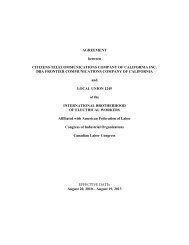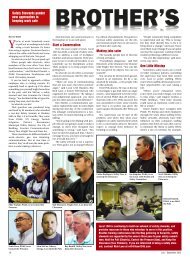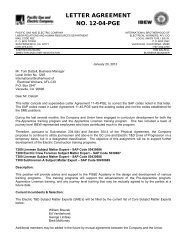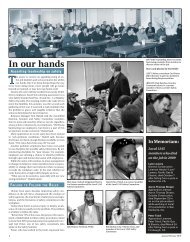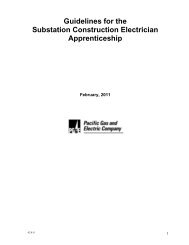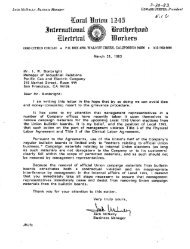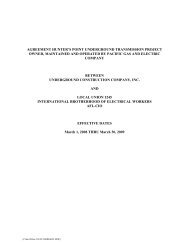NCPA - IBEW Local 1245
NCPA - IBEW Local 1245
NCPA - IBEW Local 1245
Create successful ePaper yourself
Turn your PDF publications into a flip-book with our unique Google optimized e-Paper software.
Northern California Power Agency<br />
Speed<br />
New plant can be fired up quickly<br />
Story by Eric Wolfe<br />
Photos by John Storey<br />
John Quitter walking outside the Steam Turbine building during steam blows with temporary piping installed.<br />
<strong>IBEW</strong> members are helping usher in<br />
a cleaner and more efficient energy<br />
future with the opening of the Lodi<br />
Energy Center.<br />
Owned and operated by the Northern<br />
California Power Agency, the new<br />
energy center is a combined cycle plant<br />
that generates electricity with natural<br />
gas and utilizes the waste heat to generate<br />
additional power from steam.<br />
Although the combined cycle concept<br />
isn’t new, the Lodi plant includes a new<br />
design feature that will help California<br />
maintain system reliability as the state<br />
transitions to renewable power. That<br />
feature is speed.<br />
“It’s very fast,” says Ken Parker, a Lead<br />
Combustion Turbine Specialist at the<br />
plant and two-year member of <strong>IBEW</strong><br />
<strong>Local</strong> <strong>1245</strong>. Speed is important when<br />
intermittent sources of power like solar<br />
and wind are a growing part of the energy<br />
mix.<br />
“It makes a great plant where there is<br />
a lot of solar and wind generation. It can<br />
come up when they’re down, and come<br />
down when they’re up,” Parker says.<br />
The plant was formally dedicated with<br />
great fanfare in August and began commercial<br />
operation on Nov. 27. It has been<br />
averaging 18 hours a day of production,<br />
with a capacity of about 300 megawatts.<br />
The <strong>NCPA</strong> is a consortium of community-owned<br />
utilities in northern and<br />
central California that banded together<br />
in 1968 in an effort to create lower rates<br />
for their member utilities. Today <strong>NCPA</strong><br />
manages seven power plant sites with<br />
a capacity of over 600 megawatts—including<br />
geothermal steam, hydroelectric<br />
and natural gas-fired plants.<br />
<strong>IBEW</strong> <strong>Local</strong> <strong>1245</strong> represents employees<br />
at 11 of <strong>NCPA</strong>’s 14 member utilities,<br />
including the City of Lodi. The union<br />
organized and began representing<br />
<strong>NCPA</strong>’s own workforce about a dozen<br />
years ago and today has members at the<br />
Lodi Energy Center as well as <strong>NCPA</strong>’s<br />
Mark Dempsey,<br />
Combustion<br />
Turbine<br />
Specialist,<br />
monitoring<br />
a filter press<br />
operation.<br />
6 January – March 2013
Dennis Stimac<br />
(Combustion Turbine<br />
Specialist) locking a valve<br />
shut on a filter press<br />
forwarding pump.<br />
geothermal facilities at the Geysers.<br />
<strong>NCPA</strong> has recently added about<br />
10 people to handle the new generating<br />
capacity.<br />
The City of Lodi is benefitting<br />
doubly from the recent <strong>NCPA</strong><br />
expansion. Not only will the City<br />
share in some of the power that is<br />
generated, it will also gain about a<br />
million dollars in new revenue by<br />
providing treated wastewater to<br />
help run the plan.<br />
Another beneficiary of the new<br />
energy center will be Silicon Valley<br />
Power, which will use the electricity<br />
to power Santa Clara’s high-tech industry.<br />
The Bay Area Rapid Transit<br />
system will use some of the power<br />
to move commuters around the Bay<br />
Area, which helps keep cars off the<br />
road and carbon out of the air.<br />
John Quitter on the phone.<br />
Matt Cottrell at the controls in the operating room.<br />
From left: John Quitter, Matt Cottrell, Mark Dempsey, Jeff Gibbons, Ken Parker and Dennis Stimac.<br />
Members ratify <strong>NCPA</strong> pact<br />
<strong>Local</strong> <strong>1245</strong> members at <strong>NCPA</strong> ratified a new agreement on Nov. 21,<br />
2012. The vote was 32-2, with 6 spoiled ballots.<br />
The new agreement raises wages 4% in 2013, 4% in 2014 and 2.5% in<br />
2015.<br />
The agreement also provides:<br />
Overtime compensation for employees who assist the Agency by<br />
telephone but who don’t physically report for work.<br />
Nine-hour enhanced rest period discretion if employee’s one-way<br />
commute is one hour or more.<br />
Enhanced meal language, to provide for Agency-provided snacks<br />
and 30 minute’s pay plus $15 for extended work day hours and for<br />
meals in lieu during emergency call-out hours.<br />
Employees who attend training classes, and are unable to return<br />
home each day, will receive $45 per-day for incidental costs.<br />
Improved protection against medical inflation, with the Agency<br />
paying a percentage of the plan premium, rather than the past<br />
practice of paying a percentage of plan premium increase.<br />
Enhanced language allowing retirees to add dependents to their<br />
retiree medical plan coverage, not limited to spouse or domestic<br />
partner.<br />
Employees will pay an increasing percentage of the member contribution<br />
to CalPERS, with employees paying the full 8% member contribution<br />
effective July 1, 2015. To offset these greater costs to the employees,<br />
the union negotiating committee was able to bargain higher wage<br />
increases than the District had been initially offering.<br />
Representing the union in the negotiations were Clay Ames, Hershel<br />
Allen, Jerry Pangle, Jim Holton and John Quitter, along with Assistant<br />
Business Manager Ray Thomas and Business Rep. J.V. Macor.<br />
Utility Reporter 7



